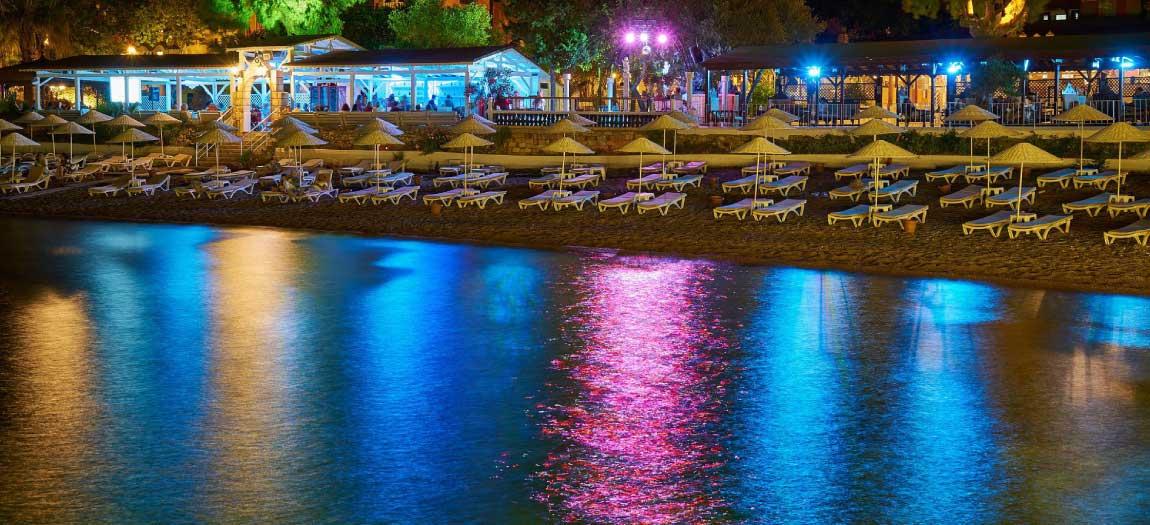Wherever human habitation spreads, so does artificial light. For billions of years, all forms of life revolve around Earth’s distinctive rhythm of day and night, light and dark. Humans have drastically disrupted this cycle, affecting the life-sustaining behaviors of wildlife species, such as reproduction, nourishment, and sleep.
Beaches have transformed from highly evolving ecosystems into brightly-lit tourist destinations and residential communities. Of all marine life, perhaps none are under more threat from lighting pollution than sea turtles.
The Impacts of Artificial Light on Marine Turtles
Light is an essential navigation tool for sea turtles. Sea turtles lay their eggs on beaches and have no further contact with their offspring. Nesting sea turtles are often deterred by artificial lights by the sea and can fail to come ashore to nest.
When they do nest, the eggs incubate in the warm sand for months before hatching. The hatchlings dig their way out of the sand during the night when the sand is cooler. On a natural, dark beach, the horizon above the sea is slightly brighter than that above land, allowing hatchlings to find the quickest path to the sea and ensuring their survival.
Artificial light along beaches disrupts the natural light cues newborn sea turtles use for dispersal. Light pollution along coastlines can confuse and misdirect newly emerged hatchlings, attracting them as they instinctively move towards the brightest area. Instead of reaching the safety of the sea, the hatchlings head towards illuminated roads, civilization, and death. Sea turtles can also succumb to dehydration, predators, and exhaustion.
Sea turtle tourism also compounds the issue as people flock to nestling beaches to witness hatchlings make their way to the sea.
That said, lighting is an important component of urban life. It provides safety and security, making neighborhoods navigable and improving the quality of life for everyone. It’s therefore essential to consider the impacts on sea turtles and other species groups when designing homesteads along the sea.
Fortunately, reducing light pollution is among the most manageable conservation practices.
SEE OUR WILDLIFE FRIENDLY LIGHTING PROGRAM
Eliminating Light Pollution on Sea Turtle Nesting Beaches
The introduction of artificial light into wildlife habitats is a concerning aspect of urbanization. Successful nesting and hatchling survival are crucial for the recovery of sea turtle populations. Improved technology, public awareness, and policy changes are all necessary to eliminate light pollution.
It’s important to follow wildlife lighting guidelines and local lighting ordinance requirements. Check with your local municipality to find out if there are any enforced lighting ordinances. These ordinances can include best practices for managing the impact of artificial light on susceptible wildlife. However, not all coastal governments have adopted lighting ordinances. In this case, there are several practices that oceanfront property owners, hotels, and resort projects can use to eliminate light pollution.
1. Keep the lighting low
The most visible lights are those mounted high on buildings and poles. These lights can disorient sea turtles and disrupt the behavior of other wildlife species. The lower the fixture, the less likely it is to be seen from the beach, and also reduces the amount of glare. Doing so also makes for more aesthetically pleasing, functional, and cost-efficient lighting.
2. Keep the lighting shielded
Some lights, such as carriage lights, disperse light in every direction. Shielding is an effective way to direct light to a specific area and minimize the spread of light. It reduces the amount of light directed onto the beach while still providing sufficient lighting for people.
There are two main ways to shield light. The first one is to use capped light fixtures that prevent light from escaping upward. Additionally, full cutoff light fixtures direct light downward and prevent the spread of light outwards. As such, there’s less risk for sea turtles to get trapped, repelled, or have their day/night cycles altered.
3. Keep the lighting long
The type of bulb you use also makes a big difference in light pollution. Short-wavelength light scatters more easily into the atmosphere, causing significant disruption to wildlife. Contrarily, sea turtles are less disturbed by long wavelengths of light, such as yellow, amber, and red. These lights appear dimmer to sea turtles and nocturnal wildlife, reducing disruptions to their behavioral patterns.
General options and recommendations
Do This
Consider employing a competent lighting designer to minimize the spread of light.
Use sensors so that lights can stay off when they’re not needed
Remove unnecessary or redundant lights in places that can be seen from the beach
Restrict usage or extinguish lights during peak sea turtle nesting and hatching seasons
Use window treatments such as blackout draperies, shade screens, or tinted windows to reduce light from high-rise buildings.
Plant a vegetative buffer between the beach and any buildings in the area
Use sea turtle-friendly fixtures and bulbs that produce low, shielded, and long-wavelength lights
Call local enforcement if disoriented hatchlings are found away from the sea
Avoid This
Installing artificial lighting in ecologically sensitive areas
Using reflective surfaces under lights as they can increase the spread of light
Importance of Artificial Lighting Design
Environmentally conscious lighting design is the only way to reduce light pollution and its impact on marine sea turtles. Whether it's dimly lighted streets and pathways or using low, shielded, and long lights, effective lighting design ensures your lights meet all the safety requirements while protecting sea turtles and hatchlings from light pollution.


